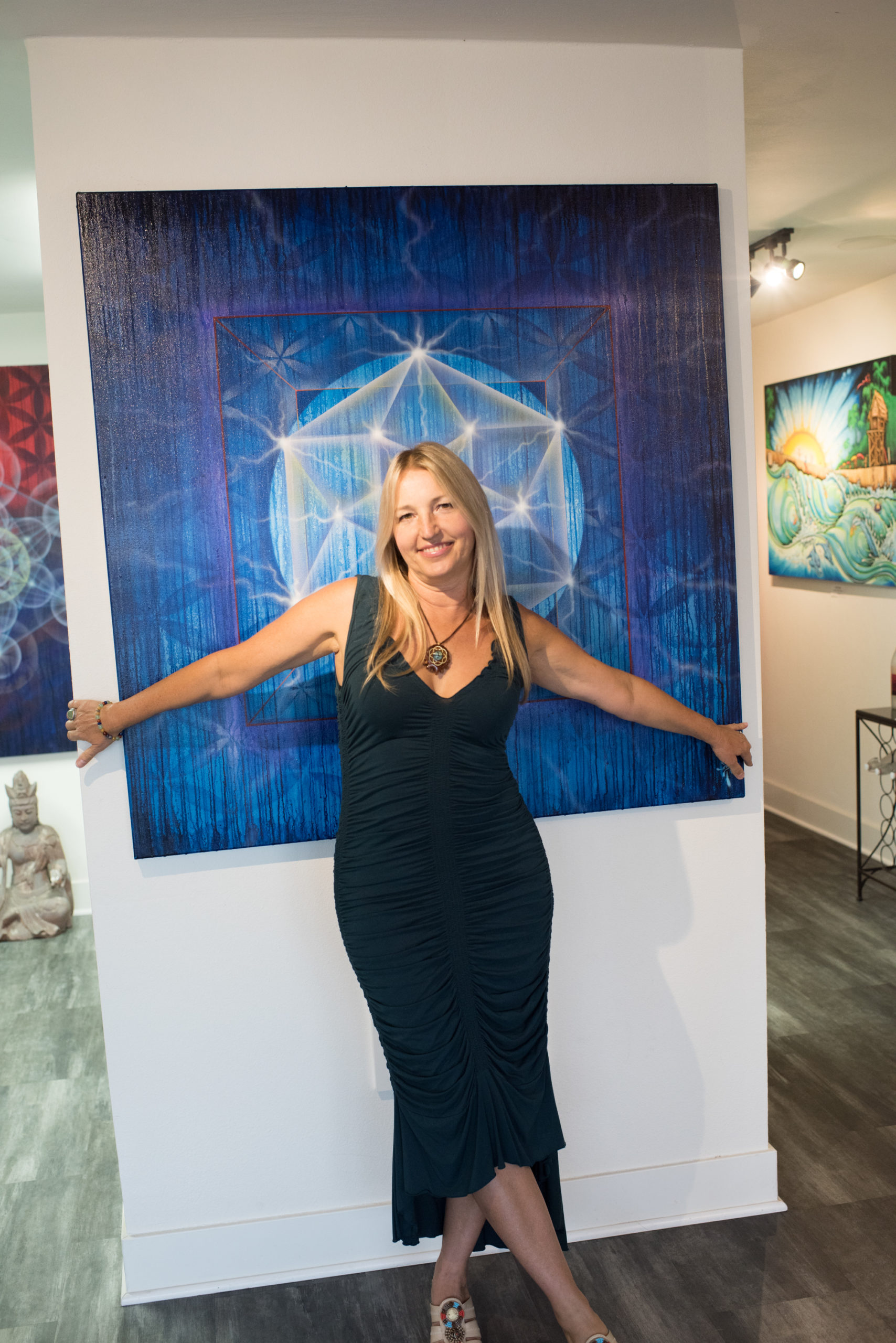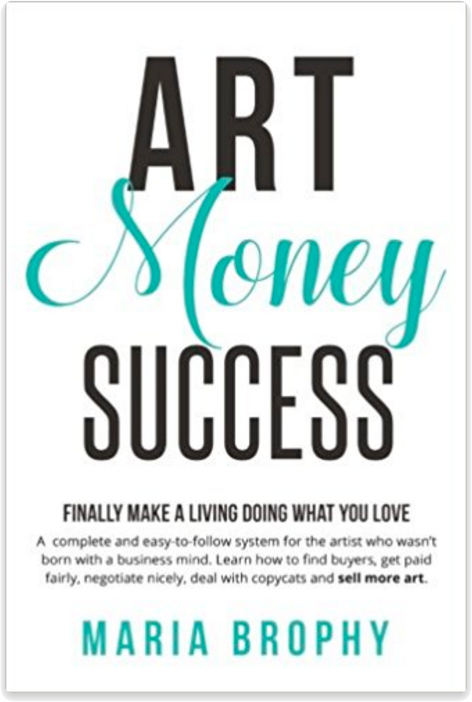 “And let’s be blunt, an art gallery is a retail business. We can pretend it’s something else and that art is not a product, but it is.” Julie Baker, President of Julie Baker Fine Art (As quoted in THE ARTIST’S GUIDE by Jackie Battenfield)
“And let’s be blunt, an art gallery is a retail business. We can pretend it’s something else and that art is not a product, but it is.” Julie Baker, President of Julie Baker Fine Art (As quoted in THE ARTIST’S GUIDE by Jackie Battenfield)
Disclaimer: My rants in no way are directed to 100% of the galleries. There are some great galleries out there, and I love and appreciate them. The real gist of this article is to encourage artists to find another way.
The art world has changed a lot in the last five years. Artists don’t need galleries anymore, thanks to the internet and a lot of ingenuity on the part of other independent artists leading the way (like artist-rebel Hazel Dooney and Hugh MacLeod).
Three reasons why I encourage artists to bypass the fine-art gallery system: It’s very difficult to support your family by selling art through galleries. I get as mad as a mother bear when artists are taken advantage of. And I get downright belligerent when an organization tells an artist what and how to create art.
Though Drew Brophy and I have had some good experiences with galleries (like the Surf Gallery in Laguna Beach), we’ve had other art dealers tell Drew what to paint, we’ve had paintings “disappear” and we’ve been urged to sign onerous contracts that would be a really bad business move.
It’s the gallery system that takes the art out of art, under the guise of being a purist, when all they are really interested in is the sales of art. Now, I don’t see anything wrong with a retail store, I mean gallery, wanting to make money. Yes, there are many exceptions to this, but I’m not talking about the exceptions right now. The problem I have is the phony art snob which pretends to care about art when they really only care about the bottom line.
Call me crazy, call me commercial, go ahead and claim that I don’t know crap about art. But I’m of the hard-headed opinion that artists should actually get paid well for their work.
Nothing vexes me more than the so called “art experts” saying that artists shouldn’t expect to live off of their talent. I read this over and over again on fine art consultant’s blogs and in books. It’s these same people that DO get paid for their work in the arts (art dealers, gallerists, consultants) that are making these assertions. Why should THEY get paid but not the artist that’s actually creating that which makes these professionals their living? Do you see the irony here?
One popular consultants’ website gives a list of “Everything Your Mother Should have Told you About Being an Artist.” Number #5 on the list says “You will not be able to make a living off of the sale of your art.” This kills me.
Why would you pay for someone to consult you when you can’t earn a living doing what they are teaching you to do?
The truth is, you can make a living off of your art, but not if you follow the old fashioned gallery rules. Drew and I are living proof of it.
Many of the conversations I get into with gallery owners about the rules of art end up in a debate. One oxymoron that I often butt-up against is that art should be kept “pure” and sold in original form or with limited high-end reproductions.
Sure, this is good for the gallery, because they will sell more originals and they get to keep more moola in their pockets. But it’s not good for John-Pierre artiste who has a wife and 3 kids to feed.
It’s an artists’ gift to the world to allow art to be accessible to most everyone, even those who can’t afford an $8,000 original painting. And there’s an easy way to make it accessible – print it on useful items.
And therein lies my problem with the old fashioned gallery system. They don’t want their artists making the art available in forms other than original paintings, because that cuts into their sales. It’s all about the money. “But artists can’t be about the money.” The double standard makes me want to spit nails.
Drew and I teach Business of Art seminars at trade shows and art stores. It’s surprising to me that the most frequently asked question is “How do I get my art into galleries?” I cringe when I get that question. I want to scream “Don’t waste your time!”
But, being the professional that I am, instead I politely detail the standard steps to find your sacred place into the gallery system: put together a portfolio, proper artists’ statement and Bio. Win some meaningless awards, do some residency time and get into a few juried shows. Contact galleries that your artwork best fits in, and take rejection well when you are appropriately snubbed for not having a long enough achievement list on your resume.
Unless you’re already very well established, the gallery system might crush you.
First, getting into a GOOD gallery if your work isn’t guaranteed to sell will be difficult. It costs galleries a lot of money to run their business. They are retail store, after all. They have to be sure your art will sell before they allot wall space to you.
Second, be prepared to pay a 50% commission on each piece to the gallery for selling your art. This means that you’ll have to double your prices just to make it worth your while. (The galleries have to keep 50%. Their brick-and-mortar costs are extremely high.)
Third, be okay with having an art dealer tell you what to paint. Some will stuff your creative side by telling you that “sky-blue color palettes are working right now” or “landscapes are selling this year.” After all, they are in the business to make money. They need you to paint what will sell, not a creative masterpiece.
To be fair, I must add here that there are a few artists doing well with their art being sold through galleries, but that’s all relative to what it means to be “doing well.” Some have to work other jobs because they can’t earn a full time living selling original art. Or their wives are working full time and supplementing their income.
I know one very well known artist in New York City. Her paintings sell in some of the finest galleries. She’s kindly helped other artists by mentoring them. The irony is that she’s a part-time artist and a full-time secretary on Wall Street. Her art is her hobby, and her job is her profession. Nothing wrong with that, but it demonstrates that even a popular fine artist who has representation in many galleries cannot go full-time on fine art gallery income alone.
Many years ago we made the decision to cut back substantially on the amount of work we did with Drew’s art in galleries. We still do exhibits, but only those that are with a group of artist friends or overseas in exotic locations. Instead, we put our energy into art sales where we make a profit. This enables Drew’s art to support our entire family and for us to continue living the life of our dreams.
I’m feeling a little guilty about placing the gallery scene in a less than magical light. But this blog is about helping creative people to design the lifestyle of their dreams. And it’s not a dream lifestyle working a job you hate just so you can sometimes find time to paint for a gallery system that will pay you very little.
I want to give a different point of view to consider. I want artists to stop stressing and realize that having your art in a gallery isn’t that important. It’s not going to make or break your career goals (unless, of course, your goals involve galleries).
Sure, there are some benefits to being associated with a gallery. It gives your artwork credibility, it exposes you to new collectors and it brings you together with other artists. If you’re working out of your own home, it gives a public location to your artwork where you can send your buyers. If your work is a proven seller, your gallery will do the necessary marketing and sales work that so many artists despise.
For fine artists, the gallery system may be a necessary evil, particularly if they are relying solely on original art sales for their income.
But, if your art is accepted in the gallery system, expect to play by their rules. And there are many rules in that world; rules that could stifle your creativity and out-of-the box thinking.
I’ve always been a rebel, and I’ve never been one to join a “system” so maybe that’s why I bristle at the thought of following someone else’s guidelines. There should be no rules in art.
For artists who want to blaze their own path and make their own name for themselves and support their families with their art, there is a better way:
- Sell your art yourself. Sell it in many different formats other than original art.
- Develop a following and a mailing list and nurture it. Hold your own shows in the homes of friends, collectors, admirers.
- Screw the rules. Try different things.
- Concentrate on developing 1,000 fans which will sustain your art career far longer than any gallery can. Use the internet to generate new fans and sell to them.
- Rely on yourself. The reality is that no one really cares about your art career better than you do.
- Take full control of your future. If you don’t know how to, then get yourself educated and learn from others. Read books and blogs of artists who have done it.
- Invest in yourself.
Having your art in a gallery won’t hurt you, and if it’s a good relationship, it can supplement all the other things you are doing with your art career. But know that you won’t be able to depend on anyone else to make things happen for you. You’ve got to do that for yourself.
Now, go ahead and comment below, please. Let me have it!
Maria xxoo
Artists “need to be savvy entrepreneurs. But they are trying, often without much success, to follow a prescribed model of working solely with galleries and keeping their fingers crossed that one day that this tired formula will work. The problem is that 99.9% of the time, it doesn’t. And if it does, too many art galleries fold.” Artist Ann Rea, during interview with Artsy Shark on how Artists can have a Strategy for their Work.










53 Responses
Thanks Maria, I really enjoy your blog and all the great stuff you give so freely, Have a good one, James V
I agree that it’s old-fashioned for artists to be dependent on galleries to make or break them. I haven’t had a bad gallery experience, but I deal with cool indie galleries that are sometimes part retail store or hair salon. It would be awesome to be represented by a fancy art gallery someday but I’m not holding my breath! Since I come from an apparel industry graphic design background, I’ve been lucky to have been trained to understand retail and consumer habits. Not everyone has the same budget so why not have something for every level of spending? Originals, limited edition, open-edition prints… Something for every fan!
Maria,
This issue is close to your heart, no wonder you sound upset.
I would not want to meet you when you are in this mood, but I am supportive of your ideas. In fact, for crying out loud…what a shame we still don’t have a handle on this issue…and in this day and age?
Correct me if I am wrong, but it is very difficult to survive as an artist especially in America. In general, Americans tend not to value art and artists so much. America is more driven by materialism, consumerism. The aesthetic culture seems to be missing. In general, Americans tend to be more business-oriented. By contrast, art and artists are actually valued more in other cultures and countries. At least this has been my experience, and a lot of people have told me as well. I have read books and watched documentaries.
However, I am happy for you and Drew–after all, I am your well-wisher–that you are able to make a decent living. I like to see artists who can provide for themselves. I feel very uncomfortable with the “starving artists” who earn fame posthumously or never at all.
If only we had more institutions and organizations supportive of the arts and artists. Unfortunately, too many individuals still consider art passe and think of artists as druggies, social parasites and welfare mom types. In our society, we need patrons of the fine arts. Artists should be encouraged both in terms of material rewards and emotional/moral support. Yeah, right: and pigs have wings!
I fully agree with Archan Mehta. I am from Europe he is from somewhere else but the outsiders view on art in US probably is exactly same regardless of the places they come from. First I was thinking that that it is exactly what I should write but really nobody cares about art in US.
Is just addition to more important things. But I would go to more details which you would read as critique. One thing I find amazing that outside of US being original is a PLUS, Here in US is a problem if you do not follow the flock and your art is different if not better than average.
Great article! I’ve always scuffed at galleries myself. First of all it seems they always only want you to display your original. Well that’s fine if you don’t care about it in my opinion. Too many times while in college having done gallery exhibits has my work been miss-handled!
Sure maybe it was an accident. Maybe they really don’t care about my property enough. Either way I’ve refused to hang originals when I can hang a print that looks just as good.
Secondly, many galleries or art shows are WAY TO picky about what can be entered or what style of an artist they’ll let in. Art is appreciated by the eye of the beholder. Who gives them the right to say what should be accepted? I never understood why any artist would be turned away. With the exception that it’s a theme exhibit of course.
I think art shows and galleries are about the same. I’ve often wondered why musicians can go play a gig most anywhere and get paid for playing there. Sure it may not be much but, while they get at least a little something in their pockets, artist have to pay high dollar just to display their work! With hope that they may sell something! Then on top, with galleries, more so than art shows, you have to give the percentage on your sells. Feels like highway robbery if you ask me. They wouldn’t have a show if it wasn’t for the artist.
Of course, I guess they teach in business class that you get rich by using someone else’s money and by being a cut throat. Maybe I can’t blame them. Like you said Maria, we have other avenues; we have a choice.
“I’ve always been a rebel, and I’ve never been one to join a “system” so maybe that’s why
I bristle at the thought of following someone else’s guidelines.
There should be no rules in art.”
Cheers luv ~Dennis
i broke free of the gallery system a long time ago for these reasons & i won’t go back.
Maria:
Sometimes, these art snobs have fancy credentials, such as advanced degrees in art history and write art criticism in peer reviewed journals and are featured guests on juries and are incredibly well-connected. And fill in the blanks, will ya, please…
Some of them may have an entitlement mentality and may even be hooked on power. Not everybody handles power well, so maybe they look down upon new, upcoming artists who are more experimental.
“Power corrupts and absolute power corrupts absolutely,” is actually a famous, old saying.
There is nothing worse for an artist than having to face a museum curator and a gallery owner who are only interested in sales and profits. How discouraging to be given a lecture about art and unsolicited advice. No wonder many newbies and wannabes fall prey to self-destructive behavior: drugs, alcohol, suicide, you name it.
Thanks, everyone, for your thoughts on this topic. I think it hits a really sore chord with a lot of people. I’d be interested in hearing from those who work in the fine art gallery system and see what they have to say!
excellent points, Maria
As a hobby artist, I have already made plenty of money by airbrushing, painting and drawing ‘on things’ and then selling those things via ebay, forums, and other internet sources.
There is a local cafe that allows local artists to hang their art in the cafe with a price list for copies…. for free.
I have a career, and I don’t strive to make money with my art… it is my stress reducer but truthfully, I’m making more than enough to keep my supplies topped up and this year our family will be taking a nice ski vacation on the back of some skateboards and snowboards I painted.
Anybody who allows someone else to dictate what you should paint or how you should sell it, is unfortunately paving a sidewalk up their back.
Thanks for the blog Maria.. great points all.
AMEN Girl! I stay away from those pretentious snobs who think they KNOW art because they took some classes and got a piece of paper! Not only in the galleries, but these types of people can be found in art co-ops, show organizers, schools, art supply stores, agents, etc. They’re everywhere! Ironically – a lot of the people I’ve encountered with this obnoxious attitude DON’T or CAN’T actually produce art!
Art should be POSITIVE! You should produce it because you can’t think of anything you’d rather do! It excites you! And if you want to make a living at it – you WILL do it! You will find the avenues for sales, if you just look for them – and try different things! Be confident!
I don’t think any artist making a living with their art will say that they get all of their salary from one venue or stream! Everyone I know – that’s successful at it – receives income from many places, and when it’s added up… a LIVING is formed! I tell people it’s like a tree — the trunk is the original art piece, the branches are all the forms of production and sales (prints, magazine articles, licensing (in many different media), greeting cards, etc. What you need to strive for is a full, healthy tree! hehe
Galleries are NOT the be all and end all of being a successful artist! Neither is getting an art degree! Just follow your OWN heart!
Love your blog Maria! I really enjoy your take on things! A woman after my own heart! And tell-it-like-it-is attitude! Keep up the great articles!
Hi Maria,
This reminds me of self-publishing for art! A good way for artists to take back their power.
Way too may of us spend our entire lives looking for permission and acceptance from others, when it really needs to come from within. Why not make your own gallery!
Thanks. Giulietta
Maria – This is incredibly helpful. Your blog is full of great insights and inspiration! Thanks, Philip
I pay one third commission to any gallery who sells for me. The 50 percent thing got tired. So…Please don’t assert that 50 percent thing. The old way was always one third commission. It is traditional. I have re-adopted one third max as the commission I pay. Please pass the word along. 50 percent was way too much …If all artists form some solidarity back to one third as standard commission we will be able to get this thing back in check. Thanks, Sari…
Sari, thanks for pointing this out! Yes, 30% is another way to go, and it’s for sure preferable!
I agree, if all artists encourage galleries to go with 30% to the gallery and the rest to the artist, than the entire system would go back to that.
You’ve got me convinced. I will no longer say 50%. Thank you!
No reputable gallery will negotiate commissions with potential artists. There are tons of artists that will gladly give up far more than even 50% to be represented. Saying , “I’ll give you 30%” is the same as saying “I think I’m better than all those other suckers you represent who negotiated 50%…so please pass me over because I am obviously difficult to work with”. I’ve never encountered a gallery that did less than 50% commission except for community galleries.
Hi gorgeous dollface!
Remember, one third is actually about 33.33 percent, a little more than 30 percent. One third was traditional throughout the art world of old.
So if you are asking $900 dollars retail, the gallery takes 300 dollars, you keep 600 dollars, which covers 300 dollars in your costs & you get 300 as profit…Divide by three, you keep 2 parts, gallery gets one part.
Sari
p.s. You can just say “I’ll give you one third of the retail take”…
when querying a price recently, i was informed that what ever the frame costs add the same for the artist and the same for the gallery, ie a third. i know the gallery and framer have overheads, but how wrong is that.
great information, great site.
My experiences with galleries are few, as I’m just starting out; but what I *have* experienced has left a bad taste in my mouth. I can’t get past the 50% cut part. It just seems wrong for me to do the lion’s share of the work, and give someone half the sale for letting me use their wall.
I know that not all galleries are like this, and some really work hard to promote an artist’s work (earning that 50%), but I haven’t gained entry to such a gallery yet.
I really enjoyed reading this post. I do know some artists who sell solely through the gallery system do very well, because my husband worked full time for a very prolific and enormously successful artist until her death almost two years ago. But because of that experience, I also know how badly some galleries mistreat artists. I know a couple of great gallery owners, but I’ve heard horror stories about others. And yes, 50% commission is the norm at most galleries. I currently have some of my jewelry in 2 shops and 2 galleries, and I also sell artwork and jewelry online and at shows and home parties. I much prefer having more control and getting more of the profits from my sales. I’m considering pulling my work out of the galleries and focusing more on the lower commission shops and selling more of my work myself directly to customers.
Replying to my own comment. I said 50% was the norm at most galleries, and unfortunately it is–at least at the very high end galleries where that artist my husband worked for sold her work. The two galleries I sell at are closer to the 35% mark.
Kelley, thanks for commenting and for your information. It’s so helpful to find out what other artists experiences are. I think 50% can be high, particularly if the artist is paying for the framing. If the gallery pays for it, it’s reasonable. But there are just so many variables to consider….
Maria,
Couldn’t have said any of this better myself. You and I think an awful lot alike. I too often get asked how does an artist get gallery representation.
Funny thing is, not one artist I know got into a gallery with a submission – it was always by recommendation from another artist or collector. One popular gallery recently admitted to one of its artists that they have submissions they’ve never looked at that have been sitting around for 5 years. They just don’t make artist submissions a priority – and why should they when they choose via competitions and magazine articles.
I’m with you, I think artists can do much better on their own these days. Of course that means investing in our own art marketing, but even marketing can be done rather inexpensively these days with the Internet.
You’ve got the guts to say things as they are… for most artists. Very few make a living through galleries… many more make a living without them or with a combination of venues.
No gallery should tell us how to run out business. We pay them a commission to be our sales people. We don’t work for them, they work for us. I’m tired of being told what and how to paint. Ooh… don’t get me started …. lol.
Lori
Wow! I had no idea about all of this.
Well, this year I´ve got accepted on a gallery on NY. They asked me money upfront for a representation, plus a commission for the sales. I was ok with the commission, but I hadn´t the money to pay upfront. And it wasn´t cheap!
It´s really interesting to get to know about all this info. In fact, I find all your articles really interesting. I´m glad I´ve stumbled upon your page 🙂 I´m reading it all!!.
Thanks a lot for making this!
I´ve already subscribed to your newsletter!
Hugs,
Mako
Mako, I would say NEVER pay someone money up front to market your work unless they are guaranteeing a certain return, as well as a laundry list of what work they will do each week to market you. It would be cheaper to hire a personal assistant – but I think most artists are capable of marketing themselves just fine.
Once again, a VERY helpful article. This is perfect timing that I found your blog- i have been lost on here for hours!! thank you so much for sharing your experiece and expertise!
Thanks, Tanya. I’m so glad you found my blog!
Here’s a great article on the topic of artists and galleries working together on Lori McNee’s site: http://www.artprintissues.com/2010/05/visual-artists-challenge-should-i-work-with-galleries-go-direct-to-collectors-or-both.html
It’s more food for thought on this subject!
“I looked at your art & website and heartily agree that expression is the foremost urge for an artist. Formal execution & obtaining a realistic likeness of reproduction has its place, but expressing your vision is key. Enjoy the journey”…an American Art Magazine editor’s comment.
“I have looked at your website and given it much thought as to whether we could work together or not. The answer is no because your website is too strong”…a leading UK Art Gallery owner’s comment.
So stick with it and as you say my art is my contribution to society, better still the world.
Thanks Maria; i’m sure you’ve made a lot of artists feel better. I’m an older (and better) artist and have used different methods of selling. I’ve had my paintings disappear from galleries, my payments held up, and one gallery owner has disappeared off the face of the earth, it seems, along with several of my oils. We have to be very careful and protect our babies. Also, it often pays to humble ourselves and show our work where the most people will see it.
Excellent post.
Art collectors are the angels that provide support for artists & the arts that make it possible for artists to put more beauty into the world…
But do the galleries work hard enough for their cut on your behalf?
The ART Gallery is everyday life
I think the most important use of art is in Everyday life, We see so much of it that actually we stopped realizing that the output in form of a product, newspaper, even TV screen is result of somebody doing creative work.
When I am looking for example and comparing textile the most important difference between this or that is the art in form of a pattern printed on. Better work of artist translate direct in bigger sales to bigger profit for the manufacturer.
Fact that most people do not recognize this fact is just sad remainder how blind and limited we are.
I remember when I came first time to US the one of the most striking images was the shape of the cars and I remember some of the comments about it from many immigrants I met. Immigrant who used to apply different set of aesthetics at home than the designers of the cars in questions.
Even today we see so many “Batman” cars on the streets produced and designed not only in US but mainly in Asia.
Same engine and mechanical parts dressed up in better looking body shape can generate more interest. And this is work of the Artist-designer
Our cultural background determine in many instances the output and unfortunately you are able to compare only when you saw many different examples in many cultures. So guys TRAVEL to be better artists.When I did some posters in Sweden people immediately recognized my work as work of a foreigner and in not bad terms.
Here in US we are living in society isolated from outside word.
For example looking at the pictures of Rome is not going give you Personal experience , absorb the feeling or learn about people behind their work. Go there and stay for a while to absorb and learn. First few days you going bring with you air bubble from your home country surrounding you and preventing absorption of the actual experience. …………I think i am off the subject Sorry
Thanks for this post, Maria! I have recently discovered your blog.. and am devouring it! This post really spoke to me. I’ve long suffered the childhood idea that to “make it” you need gallery representation – some status idea I suppose. I’m so glad that you’ve broken it down for the hard headed, like me, who take time to understand it differently. 🙂 Others have tried, but you reached the tipping point. Love your writing.
While I don’t have contacts at any fancy galleries…. Over the years I have had my paints hang at Starbucks, and a Restaurant, at a hair salon, in a clothing store, at a tattoo shop, at a gallery for a “surf art show” and at an “Art Walk”. Some of these locations had great foot traffic, and some were known as “Art venues”. For all the trouble and fuel and promises I sold 2 painting combined total at $210. I have been better at selling art directly, although not much better, but enough to prove your message is truth.
I like this line Maria “Concentrate on developing 1,000 fans which will sustain your art career far longer than any gallery can. Use the internet to generate new fans and sell to them”
Maria, you and I think a a lot alike, and I get a lot of artists asking me how to get into galleries.. I too think that or most professional artists it’s a waste of time, like you say in this blog.
Many of my artist friends who have worked successfully with galleries for decades can no longer depend on them to make a living. Many have closed, and those that do exist are selling online or from ads. No middleman is needed any longer, and for me, working without galleries has allowed me to sell at more reasonable prices.
I also totally agree with you about selling in many formats. Artists can spend more time creating masterpieces if they sell reproductions, and because the prices are lower, they have a much larger audience. Passive income is how artists sustain themselves during slow economies, and what happens if the artist can’t paint for some reason? Having a steady supply of art formats that provide passive income is like an insurance policy.
I’m so glad you spoke up. You said it eloquently and truthfully.
Lori
Dear Maria,
As a person trying to merge street art with advertising I feel your frustration. Commercial and creative can go together but it is often the business side that dominates the discussion when it fact its the creativity that has the real value to begin with. But luckily, your are right, the internet is giving the power back to individual. So is technology. It used to be that creating a series of stunning prints was limited by the techniq but with the advent of Giclee printing not only can people create incredible quality prints but they can also be priced at a level where more people can enjoy them. Galleries play a role but ultimately it is the art they need in order to generate business.
Goodluck and you should be bashing the gallery world. They could use a good shake up and a big awakening to the new world.
Jim
I’ve never really bothered to show my art at galleries unless I was invited and luckily each place that invited me had very low commissions because they were part of a non-profit. I’ve done a few art fairs, art walks, etc but haven’t had much success with those. One reason I don’t bother showing my art in galleries is because I want to keep my originals as affordable as possible.
The best marketing I ever had was pretty funny. I used to work as a barista at a coffee shop. The owners commissioned me to make their bathroom signs which were full paintings on canvas. Every day at work it was like having a mini-art show and I got at least 4 gigs out of that. One of my connections from that experience ended up giving me even more work over the years, he’s purchased 4 paintings from me and has marketed my work to his friends and family.
It does seem like an uphill battle especially when people don’t see it as work, but only as benefiting the artist as self expression. I’ve definitely established that I want to continue making art, but in the bit of dabbling I’ve done to try to sell it I’m finding it’s quite a challenge to get people to pay for it…
BTW, I love your stance on this! 🙂
As a director at an art gallery I can tell you that yes we are picky about who we work with. We need artists that can sell and appeal to our buyers as well bring in their fans and buyers to the show. We bring international artists and there is a lot of overhead to ship in the work and then bring the artists to stay in a residency pre-show. We spend about $4,000-6k in just bringing the work to the USA and putting up our artist. Then there are framing costs. Then we do the prints and silk screening in our gallery. The labor to paint the walls, hang the work, pay staff, alcohol on the night of the event. Not to mention the three or more full page ads we do in art magazines about $3,000 a piece. We pay a videographer/ editor and photographer to cover the event. Then the costs of lunches and p.r. follows ups with good clients. We have to be constantly sending work, reaching out through social media and the like to our database and be aware of growing and finding new collectors. The overhead to rent the local is $5,000 a month. So if an artist has he potential to sell $25,000 of work in one month or opening night, we are breaking even. So, galleries are definitely not for every artist. And this is why indeed 50% is fair as a commission. The beauty of setting higher prices is also the artist’s value goes up. May I also add the art fairs cost an arm and a leg. About $20,000 to rent a booth plus the shipping costs and framing and the expense of the trip and hotels. We must make at least $40,000 in three days to say we did ok and it was worth it.
This is a phenomenal post. Most artists are taught from a young age, through high school and through college that the gallery/museum route is the way to go. You are constantly sold lottery tickets promising substantial winnings if you get the “right” exposure, told to chase grants, hold down a non-art day job to pay the bills, etc but in the end, it’s the artist who ends up paying, in debt, & exploited. No bueno. Thanks for giving us all a voice and fighting the good fight 🙂
I am sorry to hear that you have had such a bad experience with galleries. I am owner of a custom framing shop where we also have an art gallery and do fine art printing. We love seeing all the art that passes through our doors and enjoy interacting with artists as well. We are not exactly a “fancy gallery” I would say. We carry art (orginials, prints, etchings, limited editions) from all over the world and different price ranges. We usually buy directly from the artist or dealer at a 30 – 50% off retail price since we have to resell it and frame it, but I usually buy in bulk. If I do commission I try to price things fairly so the artist still leaves with a bigger chunk, since it is, after all, their work. But as other gallery owners might say I pay thousands a month for a storefront area, I pay every time someone swipes their credit card, i pay for insurance and employees, I pay taxes for every item that is sold and I pay tax on any profits I make, and that doesn’t begin to list my expenses. I do believe that in selling artists work I deserve a fair percentage. I love working with artists. Selling, framing, and even printing there work. We are hoping to have art shows soon, and not just shows to show what we have in the art gallery but to let artists bring in work that isn’t represented in the gallery. There is nothing wrong with selling your own work but don’t give up on art galleries, at least not those that enjoy having your work and working with you. I would never tell an artist how to do their art, but I do pick and choose what to represent in the gallery as we need to make sure it sells if we will be putting money into it, although I believe we have quite a variety in style and media. This is why I hope to hold shows soon, so artists that aren’t represented can still show their work and get their name out there. As an artist myself I do understand the importance of criticism. I would never give my input on an artist’s work unless asked, but I do believe that if an artist wants to excel and prosper they are going to have to take advice, whether they want it or not. I do all the time with my illustrations and photography, and I still have a lot to learn. As a gallery owner I use a storefront and a website to get the art out there, which will soon be opening an online store. It’s great to sell art yourself but certain art galleries can still be a great thing to partner with if you find the right ones. The only time I enforce contracts are for licensing and selling prints and commissions. Things like these need certain terms to know what royalty fees and commissions certain parties get, but you should always read them through and if you are not comfortable try to negotiate or don’t sign it. Also working through dealers and galleries help small businesses as more people involved make money which in turn helps our economy! Example: An artist sells through a dealer, who sells to me, then I frame it, paying my framing vendors and sell it to a customer, lots of people and companies involved make money. I hope that this helps shed a light on some us art gallery owners who really enjoy what we do and enjoy the people we work with.
From my point of view the problem is not only with gallery system here in USA But is that the middleman quite often picks the average and hide the excellent trying first to unload the average and later on afraid to show the excellent because it will make to big competition for Average. I experienced quite few situations in this area. New and unusuall despite all the rumors about “looking for new” is not what seller will pick in first place. What can not be categorized and put on the mental shelf along with similiar is left in cold. “Proven” is in demand. Same way like new worker without experience is undesirable. Have you hear expression “too competetive” I did. “Rare” is undesirable etc
This guy speaks the truth. And most galleries either can’t differentiate between good and bad art (let alone average and great) or don’t care. The artist’s educational pedigree and previous representation/awards is a huge factor in the gallery’s decision to take them on or not. Galleries want to be taken seriously by the establishment so they tend to carry a lot of crap that they can’t unload. It’s a twisted system created by a perverse symbiosis of education, critics, curators, museums, banks, and collectors. The artist is the ball in the pinball machine.
Hi, I’m not sure this is the right place to ask. As an artist just starting out, my professors told me that I had to spend money to make money, and that I had to shell out to apply to juried exhibitions in hopes of one day getting my art in a gallery- but not to ever make money. And I’ve heard elsewhere that I should never pay to apply because why would a gallery want to sell my work if they already made money off of me? And I’m not sure what I should do.
Hi Megan, thanks for the question. My answer is: Don’t take advice on how to earn a living with art from anyone who has NOT done it themselves. Paying to show in a gallery is not a good sales plan! If your goal is to earn a living with your art, then make a rough business plan that is focused on earning money/selling art immediately, and learn the different ways to do so. You can begin learning by signing up for my email newsletters (sign up at the top of my website) and reading the many free blogs out there written by artists who earn money with their art. I wish you the best!